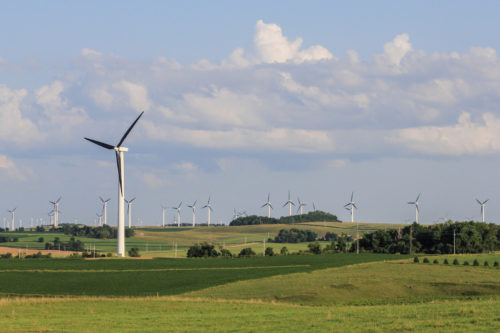
Lowering Costs and Carbon for Minnesota Co-ops
Coal Plant Retirement Will Likely Save Rural Minnesotans over $60 Million Annually
Today, Great River Energy (GRE), a generation and transmission (G&T) cooperative utility serving 700,000 families and businesses in Minnesota, announced the planned retirement of its Coal Creek Station power plant in 2022. This retirement is part of a sweeping plan to reduce the utility’s CO2 emissions by 95 percent compared to 2005 levels.
The utility plans to replace the electricity it currently generates at Coal Creek, a 1,100 MW coal-fired power plant in North Dakota, with over 1,000 MW of new wind, solar, and battery projects across Minnesota and neighboring states over the coming years. In recognition of the economic importance of Coal Creek Station to its surrounding community, the utility also announced plans to support the economic transition ahead for the broader region.
With the announcement, GRE has taken a decisive step toward capturing the economic benefits of clean energy on behalf of its members across the state. Rocky Mountain Institute (RMI) analysis of public data for Coal Creek and the broader Midwestern electricity market suggests that retiring the coal-fired power plant will save co-op members over $60 million annually. GRE’s announced investments in clean energy will also bring new economic development opportunities to rural communities in Minnesota and beyond.
Driven by the new economic reality in the United States, where most existing coal-fired power plants are more expensive to continue operating than building new wind and solar projects, GRE’s announcement is likely a portent of things to come for rural Minnesotans.
After Coal Creek retires in 2022, seven other coal-fired power plants will still be providing power to Minnesota co-op members. RMI analysis suggests that, combined, these seven power plants have created more than $2 billion in losses for their owners since 2015 relative to retirement and replacement at prevailing market prices. Given the continuing price declines for renewables, GRE’s decision to retire Coal Creek is an early indicator of how Minnesotans can save money with a transition to clean energy; we don’t expect it to be the last.
Co-ops Leading the Way
This decision by GRE is only the latest example of how cooperatively owned utilities can take a leadership role in the clean energy transition. In 2020 alone, GRE is the fourth G&T to announce a shift in its generation mix away from legacy coal-fired power plants and toward clean energy, following similar announcements from Hoosier Energy in Indiana, Dairyland Power in Wisconsin, and Tri-State in the West.
Importantly, the unique business model of co-op utilities means that the economic savings achieved through a transition to clean energy will accrue entirely to rural co-op members themselves through lower electricity bills.
Co-ops across the United States are also partnering with their communities to ensure that the economic benefits of new wind and solar project investment provide value to members’ rural communities, and that disruptions caused by the retirement of coal-fired power plants—which can be the economic foundation of rural communities—are proactively planned for and managed as part of the transition.
At Least $60 Million per Year in Savings to GRE Members
Coal Creek Station, with its two units built in 1979 and 1980, has long provided electricity to Minnesota customers in GRE’s service territory. Historically maintaining relatively low operating costs, it has operated steadily in recent years, but with increasing recognition on the part of the utility that its long-term future was uncertain. In 2013, GRE began paying off an increasing share each year of its outstanding debt associated with Coal Creek, to allow for an earlier-than-anticipated retirement date driven by the falling costs of replacement resources and other market dynamics.
Now, in 2020, the economic advantages of clean energy are even clearer. Utilities in the Midwest and Western United States continue to see record-low prices for new wind and solar projects, providing market evidence that building new renewables is generally less costly than continued operation of aging coal plants. New renewables projects, flat demand for electricity (even before the present economic downturn), and inexpensive shale gas have continued to push down market prices for electricity across the United States, with coal plants often most exposed to the resulting economic pressure.
In the case of Coal Creek Station, these economic pressures, and an associated opportunity to transition more quickly to renewable energy, have come to a head. Based on analysis of public data for both Coal Creek Station and the broader Midwestern electricity market, RMI estimates that the power plant operated at a net loss of over $60 million per year on average for 2015–2018, compared to purchasing equivalent energy and capacity within the regional market. Its retirement will likely save GRE’s Minnesota members at least that much as new, lower-cost, clean energy resources are brought online.
Billions of Dollars of Additional Benefits for Rural Minnesotans
After Coal Creek Station retires in 2022, the seven remaining coal-fired power plants—located in Wisconsin, North Dakota, and Wyoming and owned by Basin Electric Power Cooperative, Dairyland Power Cooperative, and Minnkota Power Cooperative—will continue to face the same economic headwinds that have undermined the competitiveness of Coal Creek Station for the past decade.
RMI analysis of public data, utility filings, and wholesale market conditions suggests that over the past five years, continued operation of these plants has cost an excess of between $200 million and $400 million per plant compared to equivalent purchases of energy and capacity in the same period. A thoughtful, deliberate, and equitable transition plan for these plants, as GRE and other G&Ts have demonstrated in the wave of co-op clean energy leadership in 2020, could unlock billions of dollars in cost savings for co-op members, and significant economic development opportunities for rural communities in Minnesota and across the Midwest.
Cooperatively owned coal across the region, and the country, will continue to come up against the same economic shortfalls experienced by GRE, yet the member-centric, independent co-op business model remains uniquely positioned to lead rural communities through the transition. GRE has set the stage and shown that even in the midst of economic crisis, co-ops can take decisive action on behalf of their members and can lead the way toward a lower-cost, clean energy future.

